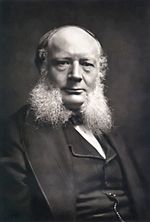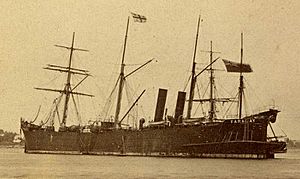Carl Wilhelm Siemens facts for kids
Quick facts for kids
Sir Charles William Siemens
|
|
|---|---|

Carl Wilhelm Siemens
|
|
| Born | 4 April 1823 Gehrden
|
| Died | 19 November 1883 (aged 60) |
| Nationality | German/British |
| Occupation | Electrical engineer, businessman |
| Known for | Siemens-Martin process |
| Spouse(s) | Anne Gordon |
| Parent(s) | Christian Ferdinand Siemens and Eleonore Deichmann |
| Relatives | Ernst Werner von Siemens, Carl Heinrich von Siemens, Alexander Siemens |
| Awards | Albert Medal (1874) Bessemer Gold Medal (1875) |
Sir Carl Wilhelm Siemens FRS FRSA (born April 4, 1823 – died November 19, 1883), also known as Charles William Siemens, was a brilliant German-British engineer and businessman. He made many important inventions, especially in the fields of electricity and heat. His work helped shape the world we live in today, from how we make steel to how we send messages across the ocean.
Contents
Biography of Charles William Siemens
Carl Wilhelm Siemens was born in 1823 in a village called Lenthe, near Hanover, Germany. He was the fourth of fourteen children in his family. His family, the Siemens, had a long history in the town of Goslar since 1384.
One of his brothers, Ernst Werner von Siemens, became a very famous electrician. William worked with Werner on many of his inventions. He also had another brother, Carl Heinrich von Siemens, and a cousin, Alexander Siemens, who were involved in their family's engineering business.
In 1859, William married Anne Gordon in London. She was the daughter of Joseph Gordon from Edinburgh. William became a British citizen, which meant he was officially part of the United Kingdom. He was made a knight – becoming Sir William – just a few months before he died.
Sir William Siemens passed away on November 19, 1883. He was buried in Kensal Green Cemetery in London. A special glass window in Westminster Abbey was put in place to remember him and his achievements.
Early Life and Education
When William was fifteen years old, in 1838, he began studying to become an engineer. He went to a well-known school called the Gewerbe-Schule Magdeburg. William had a very close bond with his older brother, Werner. Werner decided to teach William mathematics so that William could focus on learning English at school instead. This plan helped both of them a lot. William's strong English skills became a huge advantage for their future work together.
William passed his school exams easily. Sadly, less than a year later, his mother died, and his father passed away soon after in 1840.
After finishing school in Magdeburg, William went to the University of Göttingen. There, he attended lectures on many subjects, including physical geography, technology, advanced mathematics, and chemistry. For a short time, he even worked with Wilhelm Eduard Weber, a famous scientist, in his Magnetic Observatory.
When William was almost nineteen, he left university to become an apprentice engineer. He was very quick to learn, and his two-year apprenticeship was shortened to just one year because of his fast progress.
In 1843, William faced a challenge: his younger brothers and sisters needed money for their education. So, on March 10, 1843, he traveled to London. He went as an agent for his brother Werner. William hoped to earn enough money by selling one of Werner's inventions in England. This invention was an improved way to plate gold and silver. He sold it to a company called George Richards Elkington. William was a keen businessman and had even paid for his trip by selling this invention. He knew his visit might not work out, but he hoped to stay in England if things went well. And indeed, he did stay!
Amazing Inventions and Career
William Siemens was trained as a mechanical engineer. His most important early work was not about electricity. His greatest invention was the regenerative furnace, which led to the Siemens-Martin process. This process changed how steel was made, making it much more efficient.
William was very interested in how heat works. He believed that heat was a form of energy, not just a substance. This new way of thinking gave him an advantage over other inventors. In 1847, he built an engine that saved heat by using a special condenser. He continued his experiments, and in 1850, he received a gold medal for his regenerative condenser.
In 1850, William set up the London office for Siemens & Halske, an engineering company his brother Werner had started in Berlin. This company made telegraphs, which were machines used to send messages over long distances. William started selling these devices and helped the company get into the business of laying ocean cables. The London office later became Siemens Brothers in 1858.
In the 1850s, the company helped build long-distance telegraph networks in Russia. By 1863, Sir William had his own cable factory built in Charlton, London. In 1867, Siemens completed a huge project: the Indo-European telegraph line, connecting Calcutta to London.
From 1859, William Siemens spent a lot of time on electrical inventions. The Siemens Telegraph Works in Charlton produced many telegraph machines, cables, and other equipment. In 1872, Sir William Siemens became the first President of the Society of Telegraph Engineers, which later became the Institution of Electrical Engineers.
In 1860, William Siemens built an experimental gas engine. He also invented the hot tube ignition system, which was used in many early gas engines. He chose to focus more on his furnace inventions because they seemed to have a bigger impact at the time.
In 1862, he was elected a Fellow of the Royal Society, a very important scientific group.
One of his most important inventions was the electric pyrometer, which measures very high temperatures. This invention connected his work in electricity with his work in metals.
In 1874, he designed a special cable ship called the CS Faraday for Siemens Brothers. This ship was used to lay underwater telegraph cables.
In 1881, a Siemens AC Alternator (a machine that makes electricity) was used to power the world's first electric street lighting in the town of Godalming, United Kingdom. This was a big step forward for modern lighting!
See also
 In Spanish: Carl Wilhelm Siemens para niños
In Spanish: Carl Wilhelm Siemens para niños



